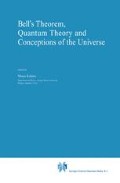Abstract
The wave function for a spinless charged particle in an electromagnetic field is decomposed into two probability amplitudes, one for a particle and one for an antiparticle. The particle amplitude is specified at the initial time and the antiparticle amplitude at the final time. Time reflection invariance indicates that the preparation of the antiparticle state at the final time should be carried out by observers composed of antiparticles. A model of elementary particles shows how relativistic quantum mechanics can be used to describe all reactions.
Access this chapter
Tax calculation will be finalised at checkout
Purchases are for personal use only
References
Marx, E. (1969) ‘Probabilistic interpretation of relativistic scattering’, Nuovo Cimento 60A, 669–682.
Marx, E. (1970) ‘Relativistic quantum mechanics of identical bosons’, Nuovo Cimento 67A, 129–152.
Marx, E. (1987) ‘Causal Green function in relativistic quantum mechanics’, International Journal of Theoretical Physics 26, 725–740.
Stueckelberg, E. C. G. (1942) ‘La mécanique du point matériel en théorie de relativité et en théorie des quanta’, Helvetica Physica Acta 15, 23–37.
Feynman, R. P. (1949) ‘The theory of positrons’, Physical Review 76, 749–759.
Walter, J. F. and Marx, E. (1971) ‘Pair annihilation at a potential barrier in time’, Nuovo Cimento 2B, 1–8.
Marx, E. (1985) ‘The composite electron’, International Journal of Theoretical Physics 24, 685–700.
Marx, E. (1986) ‘The composite proton’, National Bureau of Standards IR 86–3370.
Author information
Authors and Affiliations
Editor information
Editors and Affiliations
Rights and permissions
Copyright information
© 1989 Springer Science+Business Media Dordrecht
About this chapter
Cite this chapter
Marx, E. (1989). Relativistic Probability Amplitudes and State Preparation. In: Kafatos, M. (eds) Bell’s Theorem, Quantum Theory and Conceptions of the Universe. Fundamental Theories of Physics, vol 37. Springer, Dordrecht. https://doi.org/10.1007/978-94-017-0849-4_19
Download citation
DOI: https://doi.org/10.1007/978-94-017-0849-4_19
Publisher Name: Springer, Dordrecht
Print ISBN: 978-90-481-4058-9
Online ISBN: 978-94-017-0849-4
eBook Packages: Springer Book Archive

